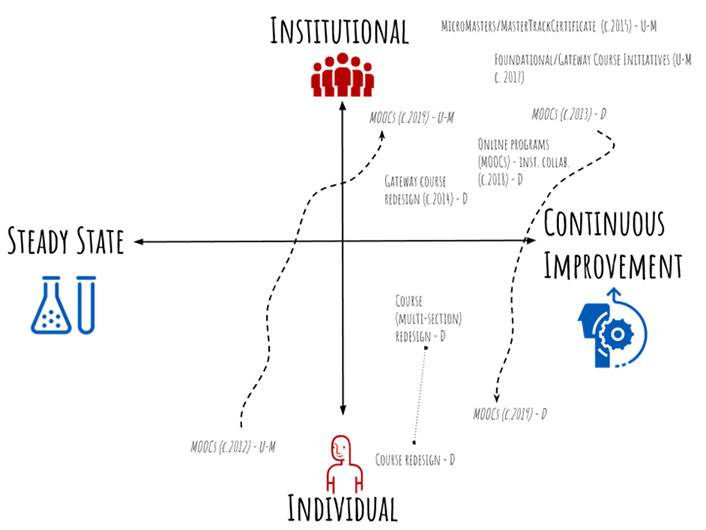The cultural context for innovation influences the skills that faculty need to successfully improve the status quo of learning.

What are the core competencies that faculty innovators need in order to be successful in making sustained changes in and beyond their classrooms? While sitting under the starry Arizona desert sky near Bioshphere 2 during an NSF-sponsored workshop focused on the intersections of STEM education; diversity, equity, and inclusion; and innovations in learning, we decided to bring this question to our colleagues working in higher education learning innovation.
A few weeks later, we gathered with colleagues at the bright new offices of Duke University Learning Innovation for a meeting of HAIL (Harvesting Academic Innovation for Learners). We used this opportunity to ask participants to respond to and reflect upon a list of seventeen competencies, which were developed with Research | Innovation | Scholarship | Education (RISE) at the University of Michigan Medical School. We later shared this list with the readers of Inside Higher Ed (IHE) and asked them to respond. The dialogue that developed yielded a range of insights.
Innovation Competencies and Mind-Sets:
- Creativity
- Initiative
- Teamwork
- Networking
- Collaboration
- Visioning
- Enterprising
- Intelligent risk-taking
- Critical thinking
- Challenging the status quo
- Identifying problem
- Intellectual curiosity
- Flexibility
- Perceptiveness
- Positive self-efficacy
- Effective communication
- Leadership
(For a full description of each competency, see the IHE article.)
Multiple interviewees and commenters to our original IHE piece noted that we should not be thinking about innovation as an output of an individual (or team) but rather as an outcome of a particular environment. As Karen Costa commented, "As a precursor to all of these competencies, the need for faculty to be supported (financial, time, caring, recognition, autonomy) by the entire campus community. Without that, this just feels like a laundry list of expectations without the necessary support."
How might we think differently about this list of competencies and mind-sets if we account for the institutional context in which a faculty member is innovating?
We posit that innovation is about improving upon the status quo. In learning, that means increasing how much an individual learns from an experience, as well as improving the quality of the learning experience. It also can mean making the learning experience available to a broader population of learners; using data to assess the effectiveness of the innovation; and/or determining which individuals the innovation is and isn't effective for.
So, if the consensus is that environmental/institutional support is necessary to foster innovation, it follows that the context in which a faculty member is innovating then shapes which competencies and mind-sets are most important for them to have. If they're innovating in a culture focused on maintaining the status quo—or what we call steady state—they need different skills from those that would be valuable for someone innovating in a culture focused on continuous improvement.
According to our interviewees/respondents, these are the top five competencies that a faculty innovator needs, regardless of the culture in which they are working:
- Teamwork: the ability to effectively and efficiently collaborate with others in a group
- Intelligent risk-taking: the ability to weigh potential benefits and disadvantages of exercising one's choice or action to assume calculated risks
- Challenging the status quo: the ability to set ambitious goals that challenge established practices—especially when tradition impedes improvements
- Intellectual curiosity: the desire to acquire new knowledge and seek explanations for things—even when the applications for that new learning are not immediately apparent
- Flexibility: the willingness to change or compromise according to the situation
For a faculty member working in a steady-state culture, the faculty innovator takes on additional responsibilities that require different competencies, some of which were not in our original list:
- Secure in position (new): the assurance that if the innovation fails, job security remains (which often takes the form of tenure for academics)
- Personal motivation and commitment (new): driven by personal motivations to begin and sustain projects (when an institutional drive to change is absent)
- Sense of optimism (new): the drive to persist, based on the belief that projects will result in better learning for students and improvements beyond one's own institution
- Enterprising: the ability to initiate and leverage available resources to further a goal
- Leadership: the ability to motivate or persuade others to act to achieve a goal by communicating a vision, committing to the cause of the organization, and inspiring trust
What our colleagues told us with a strong resolve is that faculty innovators in any cultural context need incentives (career rewards, funding, time) in order to sustain innovative work. Incentives were also identified as important for the inclusion of would-be innovators who have career, funding, or other constraints on their time and work.
Individual faculty or faculty teams can (and hopefully will) impact their cultural context: shifting the culture around them from a steady state to one of continuous improvement. In so doing, they are decreasing the need for their colleagues to have a strong personal motivation or to be tenured/secure in their position because in a culture of continuous improvement, the institution fosters motivation for innovation for everyone, regardless of their position within or off the tenure track. As more individual faculty or small faculty teams innovate, ideally an institution witnesses an additional change: the point on the spectrum at which innovations develop moves from the individual to the institution. Examples of individual faculty innovations include flipping one's classroom, adopting a new pedagogy or technology to improve learning, or creating a MOOC that mirrors an on-campus course. Examples of institutional innovations include creating online degrees to reach new learners; developing truly interdisciplinary, problem-based curricula; and supporting centralized foundational/gateway course initiatives. In between these two poles there are, of course, innovations developed by small faculty teams or departments within a school or college.
We can look at innovations developing in spaces bounded by two tension pairs: the cultural spectrum described above (steady state and continuous improvement), and the spectrum of who is innovating (an individual faculty member or the institution). We've mapped out some of the innovations at the University of Michigan (U-M) and Dartmouth College (D) and how our own definitions of what is innovative have evolved over time (see figure 1). For example, in 2012, at the University of Michigan, MOOCs were novel and exciting; they are still exciting in 2019, but schools and colleges are strategic about the MOOCs their faculty create so that alignment exists with online degrees and residential initiatives spearheaded by school leadership. This mapping revealed that the migration of MOOCs was opposite at our two institutions. At the University of Michigan, MOOCs began as individual efforts by some early adopting faculty and since then have been incorporated into regular programs (institutionalized). At Dartmouth, by contrast, MOOCs started with a centrally funded initiative (institutional) and an open call for proposals. In the ensuing years and after that initial fund was expended, MOOCs have become part of individual faculty initiatives.

Now that we sit staring at our screens, trying to summarize our starry insights and rich conversations in the North Carolina spring, is this list of competencies steady state?
This post is part of the 2019 ELI Key Issues series, which focuses on the top five teaching and learning issues as cited in the EDUCAUSE Learning Initiative's recent community survey.
Michael Goudzwaard is a Learning Designer in Information, Technology, and Consulting at Dartmouth College.
Rachel Niemer is Director of Strategic Initiatives in the Office of Academic Innovation at the University of Michigan.
© 2019 Michael Goudzwaard and Rachel Niemer. The text of this work is licensed under a Creative Commons BY-SA 4.0 International License.
